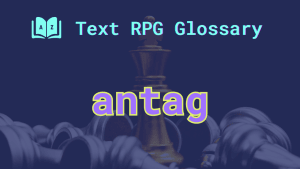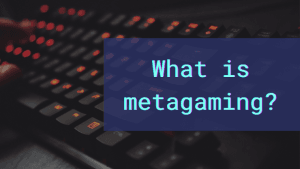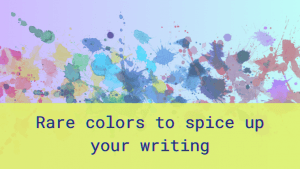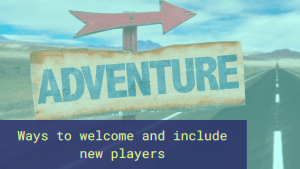What does antag mean?

Antag can mean antagonist, antagonism, or antagonistic. It refers to a style of roleplaying where a character takes on an opposing role or creates conflict for others.
This can mean playing a villain, rival, or any kind of character whose goals and actions oppose those of other player characters.
These roles are an important source of conflict and often drive narratives in roleplaying games, especially in text-based settings like MUDs, MUSHes, and play-by-post games.
A brief history of the term
Antagonistic gameplay traces its roots to the early days of text-based roleplaying, where players needed a term for characters who opposed the main characters’ goals.
In the eras of MUDs and early MMORPGs, conflict played a significant role in shaping narratives and player interactions. These platforms allowed for more complex and nuanced storytelling, where players could embody characters with diverse motivations.
As roleplaying games diversified, antag RP expanded to include not just individual characters but also broader forces of opposition, such as factions and guilds.
Modern usage
Today, the term is primarily used in games and gaming communities that focus on storytelling and narrative depth, where antagonists are central to the roleplaying experience. These settings offer players the opportunity to explore different perspectives and enrich the story by adding conflict and challenge.
Types of games that use the term include but are not limited to:
MUD, MUSH, MMORPG, Chat RPG, Social media RPG, PbP, and their respective communities.
Myths about antags
A common misconception is that antags are always the villains or inherently negative characters.
In reality, they can range from rivals and anti-heroes to characters with opposing but valid viewpoints. They play essential roles in creating engaging and dynamic narratives, not just by opposing protagonists but by adding depth and complexity to the story.
Another myth is that players of antagonistic characters are jerks or seek conflict in real life. This is not true, as the person behind the screen can have a markedly different personality and approach from their character.
Getting to play a character very different from yourself is one of the many reasons to engage in text-based roleplaying.
Antag examples
- In a fantasy game, an antag might be a dark sorcerer seeking to overthrow the kingdom, directly opposing the player characters who are trying to protect it.
- In a science fiction play-by-post (PbP), they could be a rival space captain competing for the same resources or distinction as other player characters.
- In a noir-themed MUD, they might be the mastermind criminal working against the player characters, who are detectives trying to solve the case.
- In a political intrigue MUSH, they could be an ambitious noble working against the regent in order to secure policies that benefit their own land. The noble need not be evil in this case; perhaps they’re just working hard to secure an advantageous future for their bloodline.
It’s important to realize that these characters are not always evil villains. Sometimes, they have justifiable reasons for acting against the status quo or against the established government or ruler.
Antag FAQs
What is the difference between an antag and a protag?
The main difference lies in their roles within the story. While a protagonist is typically the main character around whom the story revolves, an antagonist is a character who opposes the protagonist, creating conflict and driving the narrative forward.
In multiplayer RP games, we don’t usually call player characters (PCs) “protags,” but that’s essentially what they are. Every protag is at the center of their own personal story, and some often rise to become the main protags of an overarching game-wide story.
Likewise, antags can create conflict at different levels, too. They can create personal conflict or create conflict for larger storylines.
Can a character be both?
Yes, a character can be both an antagonist and a protagonist, especially in more complex narratives found in multiplayer roleplaying games.
This usually happens when a character has conflicting interests or faces moral dilemmas, leading them to act in opposition to some characters while in alignment with others.
For example, a character might be championing a cause to reduce inequality for the poor, but at the same time, they might be acting against a player in power that they feel is standing in the way of their other goals.
How do you effectively roleplay an antag character?
First, it’s important to understand your character’s motivations and goals, and how they conflict with those of other characters.
It’s also important to maintain balance, ensuring that your character’s actions contribute to the story without overshadowing other players’ experiences.
Lastly, many games encourage, if not require, players to get consent before engaging in RP that creates conflict.

For more advice and viewpoints on this topic, check out this thread on RP Nation or this guide created for SchoolRP (a Minecraft RP server).
Are antags always villains?
No, they are not always villains. They can be rivals, antiheroes, competitors, or any character with opposing goals or views. The key aspect is their role in creating conflict, not necessarily their moral alignment.
When creating such a character, I usually recommend avoiding conflict that leans heavily on prejudice as the main/only driver. (For example, creating a noblewoman who is prejudiced against all poor people and whose greatest pleasure is to go out of her way to make their lives a living hell.) While it might make sense for a specific theme or setting, being the target of prejudice can easily become tiresome for other players.
Check in with your fellow players regularly and make sure they’re actually enjoying the RP.
How can I create a balanced character?
To create a balanced antagonist, develop their motivations and backstory, ensuring they have clear, understandable reasons for their actions.
Give them strengths and weaknesses, avoid making them a Gary Sue, and ensure their challenges are meaningful to the plot. They should be a credible threat to the protagonist but not invincible.
How are antags chosen in a roleplaying game?
They can be chosen in various ways, depending on the game. They might be assigned by the game master, chosen by players through consensus, or emerge naturally from the story based on characters’ actions and decisions.
In many roleplaying games, the player may decide whether to play a character that causes conflict, based on the game’s setting and existing characters. Some types of games, such as RPIs, encourage conflict.




Leave a Comment